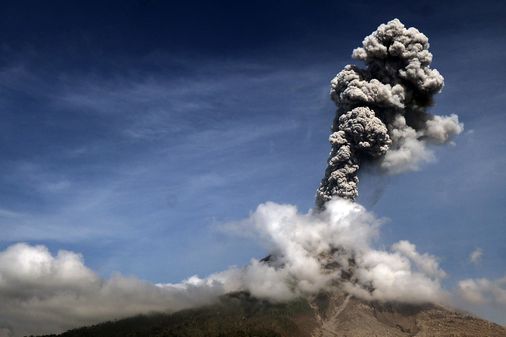Effects of Volcanic Eruptions on Indian Ocean El Niño Events Lasts for Up to 8 Years

October 27, 2023 feature
The article, after undergoing a comprehensive editorial process under the policies of Science X, reveals certain key elements while assuring its quality:
- fact-checked
- peer-reviewed publication
- trusted source
- proofread
The author is Hannah Bird, Phys.org
New research published in Geophysical Research Letters has drawn a connection between volcanic eruptions happening in tropical regions (23°N/S of the equator) and sudden interruptions of global climate cycles in the Indian Ocean over the previous 1 million years. Ocean-atmosphere climate phenomena like El Niño Southern Oscillation (ENSO) and Indian Ocean Dipole (IOD) were observed to undergo disorientation lasting nearly a decade before reverting to pre-eruption baseline levels, with the effect amplifying with the intensity of the eruption.
The IOD is the result of an east-west disparity in ocean surface temperature, with the eastern Indian Ocean showing cooler temperatures than usual and the western part being warmer. During the positive phase, the change leads to considerable shifts in temperature, wind patterns, and precipitation in the surrounding regions, generally causing flooding in East Africa and drought in east Asia and Australia. The conditions flip during a negative IOD phase.
Two researchers, Benjamin Tiger from Massachusetts Institute of Technology and Woods Hole Oceanographic Institution (WHOI) Joint Program in Oceanography/Applied Ocean Sciences and Engineering, USA, and Dr Caroline Ummenhofer, also from WHOI, utilized data from some of the most prominent historical eruptions like Samalas (1258), Kuwae (1452), Tambora (1815), Huaynaputina (1600), and Pinatubo (1991) to construct simulations using the Community Earth System Model Last Millennium Ensemble (CESM-LME).
These simulations indicated that severe volcanic eruptions in the tropics provoke a negative IOD within the same year, followed by a positive phase in the next year. This alteration significantly counterbalances the general cooling pattern witnessed in the tropics after an eruption. These positive and negative IOD anomalies endure for 7–8 years post-eruption before returning to pre-eruption state.
Another influencing factor is another concurrent climate cycle known as Interdecadal Pacific Oscillation (IPO), spanning over 20–30 years and affecting a larger area that includes both hemispheres. During positive phases, the tropical Pacific Ocean is warm while northern regions are cooler, with the opposite occurring in negative phases.
The study revealed a stronger negative IOD resulting from a negative IPO phase and vice versa. Therefore, the state of the tropical Pacific Ocean's surface temperature during IPO significantly affects the strength of the initial IOD response.
ENSO oscillations- which result in climate changes due to changes in Pacific Ocean's surface temperature up to 3°C-correspond to El Niño warming following major eruptions in tropical regions, especially winters of the year subsequent to the volcanic event. Following this is a dominance of La Niña conditions.
This phenomenon can be attributed to an intensified temperature gradient between the land and sea of Africa and the Indian Ocean, affecting the westerly trade winds, alongside a region of upwelling cooler water in the eastern Pacific. The researchers noticed that the ENSO response followed the positive IOD by 2 months. The simulations also detected negative IOD aligning with strong La Niña conditions, 3–5 years post-eruption.
Another aspect influencing the ocean's surface temperature and consequently climate responses, is the depth of the thermocline (an abrupt temperature gradient) within the Indian and Pacific oceans. Eruptions occurring during positive IPO phases lead to a shallower thermocline in the Indo-Pacific Warm Pool region and a deeper one in the western Indian Ocean and East Pacific, while the reverse situation happens under negative IPO.
In the case of positive IPO, the thermocline is raised in the eastern Indian Ocean, reducing the gradient of ocean surface temperature and thus neutralizing the post-eruption IOD. In contrast, for thermocline conditions under negative IPO, the gradient of ocean's surface temperature gets enhanced, preconditioning the Indian Ocean basin for stronger negative IPO events after an eruption. These effects are most noticeable in the initial year post-eruption and gradually diminish afterwards.
Also, the timing of an eruption plays a critical role. If it occurs during boreal spring (March–May), it is more likely to influence the IOD/ENSO response that same year. However, those occurring later might have a delayed or more neutral climate impact.
In addition to affecting climate, the aerosols released from volcanic eruptions impact global radiative forcing, the balance between incoming and outgoing solar radiation. This results in atmospheric cooling post-eruption that can last months or years, so the forcing on IOD/ENSO must be strong in order to outweigh the impact of reduced temperatures.
These findings are important for regions prone to volcanic eruptions to conduct risk assessments and prepare for the resulting extreme climate events, potentially helping to alleviate some of the impacts on the environment and local communities.
Journal information: Geophysical Research Letters
© 2023 Science X Network




